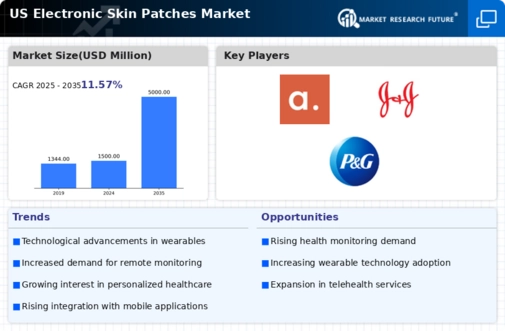Advancements in Material Science
Advancements in material science are playing a crucial role in the evolution of the electronic skin-patches market. Innovative materials, such as flexible electronics and biocompatible substances, enhance the functionality and comfort of these devices. This progress allows for the development of thinner, more durable patches that can adhere to the skin for extended periods without causing irritation. As manufacturers continue to explore new materials, the potential for improved performance and user experience increases. This trend is expected to drive market growth, as consumers seek more effective and comfortable health monitoring solutions.
Integration of IoT in Healthcare
The integration of Internet of Things (IoT) technology into healthcare is a pivotal driver for the electronic skin-patches market. IoT-enabled devices enhance connectivity and data sharing, allowing for continuous health monitoring and timely interventions. This trend is particularly relevant in chronic disease management, where electronic skin patches can transmit vital data to healthcare providers in real-time. The market is expected to grow at a CAGR of around 15% over the next five years, reflecting the increasing adoption of IoT solutions in healthcare settings. This integration not only improves patient outcomes but also propels the electronic skin-patches market forward.
Rising Incidence of Chronic Diseases
The rising incidence of chronic diseases in the US is a significant driver for the electronic skin-patches market. Conditions such as diabetes, cardiovascular diseases, and obesity necessitate continuous monitoring and management. Electronic skin patches offer a non-invasive solution for tracking vital signs and other health metrics, thereby improving patient compliance and outcomes. According to recent statistics, chronic diseases account for approximately 70% of all deaths in the US, underscoring the urgent need for effective monitoring solutions. This growing health crisis is likely to fuel demand for electronic skin patches, positioning the market for substantial growth.
Growing Interest in Personalized Medicine
the electronic skin-patches market is seeing increased interest due to the growing emphasis on personalized medicine. This approach tailors healthcare to individual patient needs, enhancing treatment efficacy. Electronic skin patches facilitate real-time monitoring of health metrics, allowing for customized therapeutic interventions. The market is projected to reach approximately $2 billion by 2026, driven by advancements in biosensors and data analytics. As healthcare providers increasingly adopt personalized strategies, the demand for these innovative devices is likely to rise, indicating a robust growth trajectory for the electronic skin-patches market.
Increased Investment in Health Tech Startups
The electronic skin-patches market is benefiting from increased investment in health tech startups, which are pioneering innovative solutions in wearable technology. Venture capital funding in the health tech sector has surged, with investments reaching over $10 billion in recent years. This influx of capital enables startups to develop cutting-edge electronic skin patches that leverage advanced technologies such as AI and machine learning. As these startups bring novel products to market, competition intensifies, driving innovation and potentially lowering costs for consumers. This dynamic environment is likely to stimulate growth in the electronic skin-patches market.

















Leave a Comment